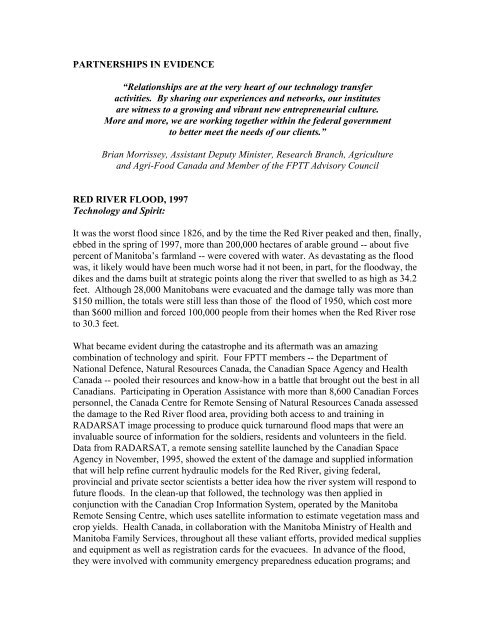FEDERAL PARTNERS IN TECHNOLOGY TRANSFER
FEDERAL PARTNERS IN TECHNOLOGY TRANSFER
FEDERAL PARTNERS IN TECHNOLOGY TRANSFER
Create successful ePaper yourself
Turn your PDF publications into a flip-book with our unique Google optimized e-Paper software.
<strong>PARTNERS</strong>HIPS <strong>IN</strong> EVIDENCE<br />
“Relationships are at the very heart of our technology transfer<br />
activities. By sharing our experiences and networks, our institutes<br />
are witness to a growing and vibrant new entrepreneurial culture.<br />
More and more, we are working together within the federal government<br />
to better meet the needs of our clients.”<br />
Brian Morrissey, Assistant Deputy Minister, Research Branch, Agriculture<br />
and Agri-Food Canada and Member of the FPTT Advisory Council<br />
RED RIVER FLOOD, 1997<br />
Technology and Spirit:<br />
It was the worst flood since 1826, and by the time the Red River peaked and then, finally,<br />
ebbed in the spring of 1997, more than 200,000 hectares of arable ground -- about five<br />
percent of Manitoba’s farmland -- were covered with water. As devastating as the flood<br />
was, it likely would have been much worse had it not been, in part, for the floodway, the<br />
dikes and the dams built at strategic points along the river that swelled to as high as 34.2<br />
feet. Although 28,000 Manitobans were evacuated and the damage tally was more than<br />
$150 million, the totals were still less than those of the flood of 1950, which cost more<br />
than $600 million and forced 100,000 people from their homes when the Red River rose<br />
to 30.3 feet.<br />
What became evident during the catastrophe and its aftermath was an amazing<br />
combination of technology and spirit. Four FPTT members -- the Department of<br />
National Defence, Natural Resources Canada, the Canadian Space Agency and Health<br />
Canada -- pooled their resources and know-how in a battle that brought out the best in all<br />
Canadians. Participating in Operation Assistance with more than 8,600 Canadian Forces<br />
personnel, the Canada Centre for Remote Sensing of Natural Resources Canada assessed<br />
the damage to the Red River flood area, providing both access to and training in<br />
RADARSAT image processing to produce quick turnaround flood maps that were an<br />
invaluable source of information for the soldiers, residents and volunteers in the field.<br />
Data from RADARSAT, a remote sensing satellite launched by the Canadian Space<br />
Agency in November, 1995, showed the extent of the damage and supplied information<br />
that will help refine current hydraulic models for the Red River, giving federal,<br />
provincial and private sector scientists a better idea how the river system will respond to<br />
future floods. In the clean-up that followed, the technology was then applied in<br />
conjunction with the Canadian Crop Information System, operated by the Manitoba<br />
Remote Sensing Centre, which uses satellite information to estimate vegetation mass and<br />
crop yields. Health Canada, in collaboration with the Manitoba Ministry of Health and<br />
Manitoba Family Services, throughout all these valiant efforts, provided medical supplies<br />
and equipment as well as registration cards for the evacuees. In advance of the flood,<br />
they were involved with community emergency preparedness education programs; and


